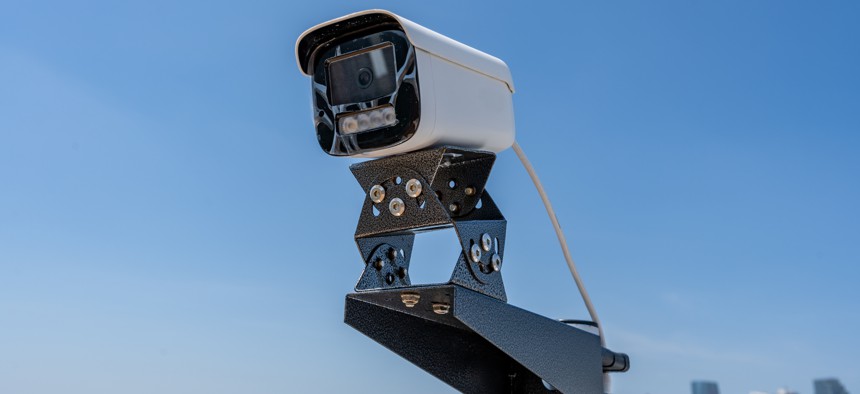NYPD Bypassed Facial Recognition Ban to ID Pro-Palestinian Student Protester

Cheunghyo via Getty Images
Barred from using Clearview AI, NYC police relied on a marshal in the fire department to run a search that turned up photos of the student at his high school graduation.
This article was originally published by The City.
A city fire marshal used FDNY’s access to a facial recognition database to help NYPD detectives identify a pro-Palestinian protester at Columbia University, circumventing policies that tightly restrict the Police Department’s use of the technology.
Details of the arrangement emerged in a recent decision by a Manhattan criminal court judge and in a lawsuit seeking information from the FDNY filed this week by the Legal Aid Society, which represented the protester, Zuhdi Ahmed, now a 21-year-old pre-med CUNY major going into his senior year of college.
Police identified Ahmed after searching for a young man accused of hurling what they said was a rock at a pro-Israeli protester during an April 2024 skirmish at an encampment at Columbia. Thanks to the FDNY’s assistance and its use of Clearview AI software, the police were able to identify Ahmed.
The FDNY began using Clearview AI in December 2022 and has an annual contract with the company, according to a spokesperson.
The fire marshal also accessed documents from the Department of Motor Vehicles that are typically unavailable to the police, court records show.
Manhattan District Attorney Alvin Bragg charged Ahmed with a felony, assault in the third degree as a hate crime, which was later reduced to a misdemeanor of second degree aggravated harassment. A criminal court judge in June dismissed the case and in a lengthy ruling raised red flags about government surveillance and practices that ran afoul of law enforcement’s own policies.
The judge dismissed the case against Ahmed last month.
“Where the state routinely gathers, searches, seizes, and preserves colossal amounts of information, transparency must remain a touchstone, lest fairness be lost,” the judge, Valentina Morales, wrote.
Clearview AI — in wide use by law enforcement agencies nationally, including the Department of Justice — matches photos uploaded to its system with billions of images in a database sourced from social media and other websites. The NYPD has used the technology in the past but now forbids its use under a 2020 facial recognition policy that limits image searches to arrest and parole photos.
A subsequent city law, called the POST Act, requires the NYPD to report publicly on its use of and policies regarding surveillance technologies. The City Department of Investigation has found the NYPD has not consistently complied. Reached by THE CITY, Council members indicated they were working on new legislation to close loopholes in the POST Act.
Social media photos the FDNY used to identify Ahmed included pictures at a high school formal, a school play and his high school graduation.
Ahmed, a Westchester resident who is Palestinian and grew up going to protests with his family, said he has received hateful mail and online messages since his arrest. He said he never thought photos from his teenage years could be used in this way.
“It’s something straight out of a dystopian, futuristic movie,” he said. “It's honestly kind of scary to think about what people are capable of in terms of surveillance.”
Privacy advocates agreed.
“The NYPD keeps using these incredibly disturbing companies to spy on New Yorkers, while hiding that surveillance from the public and violating New York City law in the process,” said Albert Fox Cahn, executive director of the Surveillance Technology Oversight Project. “The FDNY is clearly being complicit in enabling these NYPD abuses.”
The NYPD referred THE CITY to FDNY for comment. An FDNY spokesperson said in a statement that approved fire marshals have access to Clearview AI and work closely with the NYPD to investigate crimes.
“This small group of elite law enforcement agents use facial recognition software as one of the many tools available to conduct critical fire investigations,” the spokesperson said. “We always follow all local, state and federal laws.”
Shane Ferro, Digital Forensics Unit staff attorney at Legal Aid, who had represented Ahmed, sought to learn more about facial recognition technology operated by the FDNY, but requests made under the New York Freedom of Information Law, or FOIL, went nowhere. Legal Aid filed a lawsuit this week seeking to obtain the information.
The judge dismissed the case precisely because of the serious questions surrounding how Ahmed was identified, Ferro noted.
Still unknown is whether the NYPD’s reliance on FDNY to circumvent the police department’s Clearview ban goes beyond this one instance.
“The way that the NYPD used FDNY to access broader and even more unreliable facial recognition technologies — in this case, to identify a protester — brings up questions about the NYPD following its own policies, the NYPD complying with the POST Act,” she said, adding that Ahmed’s saga “brings up questions about the First Amendment and the NYPD’s prohibition on using facial recognition technology to identify people at political rallies.”
‘All Good Bro…Happy to Help’
The FDNY’s use of Clearview on the NYPD’s behalf emerged in emails disclosed as part of the case against Ahmed.
The incident at the center of the case occurred near an encampment at Columbia University by pro-Palestine demonstrators, who were protesting Israel’s war in Gaza which killed tens of thousands of Palestinians in response to Hamas’ attack on Israel on Oct. 7, 2023, where 1,200 Israelis were killed, and 240 hostages were taken.
The Israeli military offensive has since killed more than 55,000 Palestinians, according to the Gaza Health Ministry and devastated the strip.
Both former Columbia University President Minouche Shafik and Mayor Eric Adams faced pressure to quell the protests. On April 17, 2024, NYPD officers showed up at the encampment at Shafik’s request and made over 100 arrests. Students created a second encampment, and the highly militarized NYPD presence continued on campus until graduation. Cops subsequently used stun grenades, fired a gun inside student-occupied Hamilton Hall and flew drones over campus.
At Columbia, pro-Israel students often showed up to encampment events and demonstrations to counter-protest.
That was true on Saturday, April 20, 2024, when the encampment held a film screening and hosted teach-ins.
Columbia student Jonathan Lederer arrived on campus that night with his twin brother. They stood with a group behind those gathered to watch the films and waved Israeli flags, videos posted to social media show. Music played loudly out of a speaker.
Later, someone stole one of the flags and ran off, and another person tried to light it on fire. Lederer detailed his experience in The Free Press, saying he was hit in the face with objects someone threw. He later told NY1 other protesters “threw rocks at my face.”
Videos posted to social media, blurry at times, show a white object lobbed at Lederer, who appears to toss it away from him. The person who threw it flipped him the bird.
Lederer, who did not respond to emails and a call from THE CITY seeking comment, in May told the Manhattan DA’s office he’d wasn’t sure whether a laceration on the side of his face was from being hit with an object or from acne.
Ahmed declined to answer questions from THE CITY about throwing an object, but said he had been at Columbia to attend a jazz event when he’d heard chanting and walked over to the protest.
The NYPD began a search for the person who threw the object.
On June 3, 2024, the agency posted a photo of Ahmed on its Crime Stoppers Instagram account, saying he was “WANTED for Hate Crime Assault.” The posted photo was a still from a video taken at a protest in Central Park in May 2024.
Ahmed said he has no recollection of the protest or that day, but was “completely bewildered” to see his photo online with accusations he said were false.
The same day the Instagram post went up, an FDNY fire marshal emailed an NYPD detective.
“Hey brother,” the fire marshal wrote. “Good speaking with you.”
He went on to say he ran the Instagram photo “through our facial.” He said he couldn’t find the suspect’s name, but perhaps some photos he was sending along could “help with an ID.”
He attached to the email screenshots taken from Clearview AI with photos of Ahmed: one shows him at a formal event, his arm around a friend; in another, he receives his diploma at his high school graduation; and in a third, he stands with fellow graduates in their burgundy gowns. In the graduation photos, Ahmed wears a stole around his neck printed with the Palestinian flag — following a tradition that all his family members have done at graduations, he said.
The fire marshal wrote, “Not too sure what the scarf says but maybe related to Palestine?”
A different NYPD detective responded with thanks. Shortly after, the fire marshal sent links to Clearview AI face search results, an archive of school play photos and another to an archive of high school formal photos. He said he couldn’t find associated social media but offered to get a driver’s license photo for the detective. “We have access to that,” he wrote.
A minute later, the detective sent the fire marshal Ahmed’s name, date of birth and driver’s license number. Within five minutes, the fire marshal replied, “Bingo.”
NYPD detectives cannot access DMV records without permission from supervisors.
The NYPD took Ahmed’s driver’s license photo and included a digitally altered version of it in an identification array presented to Lederer, who picked Ahmed’s photo from the lineup. The photo had been edited to change the shape of Ahmed’s neck.
On June 13, the NYPD arrested and arraigned Ahmed. The following day, the fire marshal again emailed the detective: “Saw the news. Good work. Glad you grabbed him.”
The detective responded the next day: “Yea that’s to you, I appreciate the help.”
A few hours later, the fire marshal emailed back, “All good bro happy to help. Don’t hesitate to reach out again if you need anything.”
The NYPD would not have identified Ahmed but for the FDNY’s Clearview AI search and accessing the DMV photo, the judge indicated in her ruling. She wrote it was “evident that the investigatory steps described in the emails clearly contravene official NYPD policy concerning the use of facial recognition.”
NYPD may only conduct facial recognition searches within a limited repository of arrest and parole photos.
To conduct searches outside that repository, officers must get permission from the chief of department, chief of detectives or the deputy commissioner of intelligence. Employees who misuse facial recognition technology may face administrative or criminal penalties, NYPD policy states.
But in this case, FDNY’s use of Clearview’s facial recognition software trawled the Internet and yielded hundreds of matches.
Privacy advocates said they would like to see the POST Act expanded to apply to law enforcement officials who work for agencies other than the NYPD. They say that would provide insight into how other agencies are using surveillance technology, like how FDNY used to assist the NYPD.
“It should not be a guessing game, who's using this sort of technology and who's doing business with a vendor this controversial,” Cahn said.
‘The Public Deserves to Know'
In April, the Council approved three additional bills to strengthen POST Act reporting and accountability requirements, which became law without Mayor Eric Adams’ signature.
They include a law that requires tracking intergovernmental data sharing. But that only covers information the NYPD shares with other agencies, not information agencies provide to the NYPD.
Councilmember Julie Won (D-Queens), who sponsored one of the recently passed bills expanding the POST Act, said she and her colleagues are drafting legislation to close the loophole. The new bill would prohibit city agencies from using surveillance technologies on behalf of law enforcement, and mandate agencies disclose their use of surveillance technology for any reason.
“No matter what they’re using it for, the public deserves to know,” Won said.
Other Council members expressed alarm over the revelation about FDNY’s use of Clearview AI.
“This is a clear loophole we didn’t necessarily anticipate,” said Councilmember Crystal Hudson (D-Brooklyn).
Council Majority Leader Amanda Farías (D-The Bronx) called the FDNY’s use of Clearview AI on behalf of NYPD “deeply concerning” and exposed “a troubling gap in our current oversight laws.”
Councilmember Jennifer Gutiérrez (D-Brooklyn), chair of the technology committee said, “What happened here is a warning shot: without clear checks and oversight, city agencies are using powerful surveillance tools like facial recognition and AI with no accountability, no transparency, and no regard for due process.”
Councilmember Joann Ariola (R-Queens), who chairs the Council’s fire committee disagreed, saying the FDNY was within its purview as a law enforcement agency to share information with the NYPD, but that the case “may require a deeper examination at all levels.”
As for Ahmed, he said the judge dropping the case against him brought him “the greatest relief” of his life. He said he felt like the initial hate crime charge was “an exploitation of laws that are meant to protect us, protect minorities, protect any ethnic group.”
Douglas Cohen, a spokesperson for DA Bragg said: "The office conducted a thorough investigation into this matter – interviewing multiple witnesses, analyzing available video surveillance and reviewing medical records. When that investigation determined we could not prove the legal elements of the top count beyond a reasonable doubt, we moved to dismiss the charge."
Ahmed is now focused on recovering from the emotional and mental toll the ordeal placed on him and his family.
In December, he earned his certification as an emergency medical technician and plans to apply to medical school after college. He recently read a novel, ‘No Longer Human’ by Osamu Dazai, and related the story.
“Essentially, the book is about someone that gets detached from society, and he's basically isolated,” Ahmed said. “For the past year, I was scared of all the accusations, I was scared of what society thought of me.”





